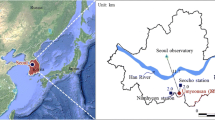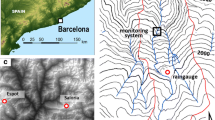Abstract
On February 6, 1994, a large debris flow developed because of intense rains in a 800-m-high mountain range called Serra do Cubatão, the local name for the Serra do Mar, located along the coast of the state of São Paulo, Brazil. It affected the Presidente Bernardes Refinery, owned by Petrobrás, in Cubatão. The damages amounted to about US $40 million because of the muck cleaning, repairs, and 3-week interruption of the operations. This prompted Petrobrás to conduct studies, carried out by the authors, to develop protection works, which were done at a cost of approximately US $12 million. The paper describes the studies conducted on debris flow mechanics. A new criteria to define rainfall intensities that trigger debris flows is presented, as well as a correlation of slipped area with soil porosity and rain intensity. Also presented are (a) an actual grain size distribution of a deposited material, determined by laboratory and a large-scale field test, and (b) the size distribution of large boulders along the river bed. Based on theory, empirical experience and back-analysis of the events, the main parameters as the front velocity, the peak discharge and the volume of the transported sediments were determined in a rational basis for the design of the protection works. Finally, the paper describes the set of the protection works built, emphasizing their concept and function. They also included some low-cost innovative works.


























Similar content being viewed by others
References
Almeida FFM, Carneiro CR (1998) Origem e evolução da Serra do Mar. Rev Bras Geociênc, S.Paulo 28(2):135–150
Araya Moya V (1994) Genesis de aluviones en la costa de zonas deserticas. I Simposio Panamericano de Deslizamientos, Guayaquil, Equador, p 186–200 (in Spanish)
Capecchi F, Focardi P (1988) Rainfall and landslides: research into a critical precipitation coefficient in an area of Italy. Proc, 5th. Int Symp Landsl, Lausanne, V.2, pp 1131–1136
Cruz PT, Massad F (1997) Debris flows: an attempt to define design parameters. Symposium on Recent Development in Soil Mechanics and Pavement Mechanics, COPPE, UFRJ, Rio de Janeiro, 409–414.
Cruz PT, Massad F, Kanji MA, Araújo Filho HA (2000) Debris flows in Serra do Mar, Cubatão, Brazil: control works and design parameters. International Workshop on the Debris Flow Disaster of December 1999 in Venezuela, Caracas, 2000 (CD-ROM), p 8
Cruz PT, Massad F, Kanji MA, Araujo Filho HA (2004) Concepts on the design of dams for debris flow mitigation. 9th International Symposium on Landslides, Rio de Janeiro. Balkema, 2: 1643–1650
Fulfaro JV et al (1976) Escorregamentos de Caraguatatuba: expressão atual, e registro na coluna sedimentar da planície costeira adjacente. I Congr Brasil Geol Eng R Janeiro 2:341–350
Guadagno FM (1991) Debris flows in the Campanian Volcaniclastic Soils (Southern Italy), Proc., Slope Stability Eng. Develop. and Appl., Inst. Civil Eng., London, pp 109–114
Gramani MF, Kanji MA (2001) Inventário e Análise das Corridas de Detritos no Brasil”, 3o.Congr. Bras. Estab. Encostas (COBRAE), ABMS, R. Janeiro (in Portuguese), pp 53–60
Heumader J (2000) Technical debris-flow countermeasures in Austria—a review. 2nd. International Conference on Debris-Flow Hazards Mitigation, Taipei, Taiwan, 553–564.
Ikeya H (1976) Introduction to Sabo Works. The Japan Sabo Works Ass., p 168
Ikeya H (1989) Debris flow and its countermeasures in Japan, Bull. IAEG 40, pp 15–33
IPT (1990) Report 28.404—Progress Report: the study on the disaster prevention and restoration project in Serra do Mar, Cubatão, S. Paulo
JICA–Japanese International Cooperation Agency (1991) The study on the Disaster Prevention and Restoration Project in Serra do Mar, Cubatão Region, S. Paulo
Kanji MA, Cruz PT, Massad F, Araujo Filho HA (1997) Basic and common characteristics of debris flows. 2nd Panamerican Symposium on Landslides and 2 Congr. Bras. Estabilidade Enconstas COBAE, R. Janeiro, 1:223–231
Kanji MA, Gramani MF, Massad F, Cruz PT, Araujo Filho HA (2000) Main factors intervening in the risk sssessment of debris flows. International Workshop on the Debris Flow Disaster of Dec. 1999 in Venezuela, Caracas (CD ROM), p 10
Kanji MA, Cruz PT, Massad F, Araujo Filho HA (2003) Triggering conditions and assessment of susceptibility of debris flow occurrence. Panamerican Conference on Soil Mechanics and Geotechnical Engineering, Boston 2:2503–2508
Massad F (2002) Debris flows generated by landslides: relationship between the slid area and rainfall intensity, 12th Brazilian Conf. on Soil Mechs and Foundation Eng., ABMS, São Paulo, 2:1223–1234 (in Portuguese)
Massad F, Cruz PT, Kanji MA, Araujo Filho HA (1997) Comparison between estimated and measured debris-flow discharges and volume of sediments. 2nd Panamerican Symposium on Landslides and 2 Congr. Bras. Estabilidade Enconstas COBAE, R. Janeiro, 1:212–222
Massad F, Cruz PT, Kanji MA, Araujo Filho HA (2000) Characteristics and volume of sediments transport in debris flows in Serra do Mar, Cubatão, Brazil, Int. Workshop on the Debris Flow Disaster of Dec. 1999 in Venezuela, Caracas (CD ROM), p 12
Mizuyama T, Ishihara Y (1988) Technical standard for measures against debris-flow—Technical Memorandum of PWRI no. 2632—Sabo (erosion control) Division, Sabo Department, Public Works Research Institute, Ministry of Construction, Japan, p 48
Morgan BA, Wieczorek GF, Campbell RH, Gori PH (1997) Debris flow hazard in areas affected by the June 27, 1995 storm in Madison County, Virginia, USGS Open file report 97–438, p 14
Rickenmann D (1991) Hyperconcentrated flow and sediment transport at steep slopes. J Hydraul Eng 117(11):1419–1439
Takahashi T (1991) Debris Flow. Monography, Int. Ass. Hydr. Res., Balkema, p 164
Tatizana C, Ogura AT, Cerri LE, Rocha MCM (1987) Análise de Correlação entre Chuvas e Escorregamentos - S. do Mar, Mun. Cubatão. .. Proc Braz Congr Eng Geol 2:225–236
Terzaghi K (1947) Memorandum concerning the slide area at the power plant. In from theory to practice in soil mechanics, 1967, 2nd edn. Wiley, New York, pp 410–415
Wolle CM (1988) Análise dos escorregamentos translacionais numa região da Serra do Mar, no contexto de uma classificação de mecanismos de instabilização de encostas. PhD thesis (in Portuguese) Escola Politécnica, University of São Paulo, p 406
Acknowledgment
The authors are indebted to Escola Politécnica of the University of São Paulo, Brazil, and to Petrobras S. A. for the opportunity to present this paper.
Author information
Authors and Affiliations
Corresponding author
Rights and permissions
About this article
Cite this article
Kanji, M.A., Cruz, P.T. & Massad, F. Debris flow affecting the Cubatão Oil Refinery, Brazil. Landslides 5, 71–82 (2008). https://doi.org/10.1007/s10346-007-0110-3
Received:
Accepted:
Published:
Issue Date:
DOI: https://doi.org/10.1007/s10346-007-0110-3




